
The Cucurbitaceae, also called cucurbits or the gourd family, are a plant family consisting of about 965 species in 101 genera. Those of most agricultural, commercial or nutritional value to humans include:
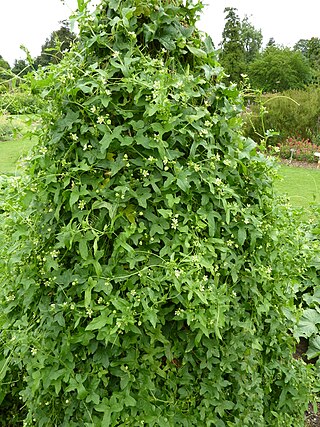
Bryonia is a genus of flowering plants in the gourd family. Bryony is its best-known common name. They are native to western Eurasia and adjacent regions, such as North Africa, the Canary Islands and South Asia.

Cucumis is a genus of twining, tendril-bearing plants in the family Cucurbitaceae which includes the cucumber, true melons, the horned melon, and the West Indian gherkin.
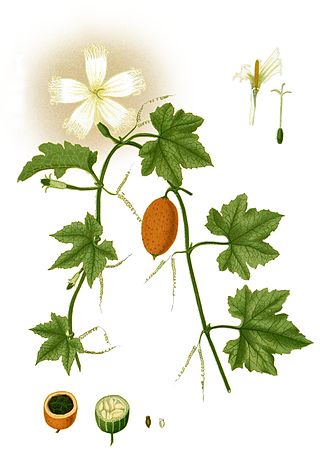
Trichosanthes is a genus of tropical and subtropical vines. They belong to the cucumber family (Cucurbitaceae), and are closely related to Gymnopetalum. Hodgsonia, formerly included here, is usually considered a well-distinct genus nowadays.
William Botting Hemsley was an English botanist and 1909 Victoria Medal of Honour recipient. The standard author abbreviation Hemsl. is used to indicate this person as the author when citing a botanical name.
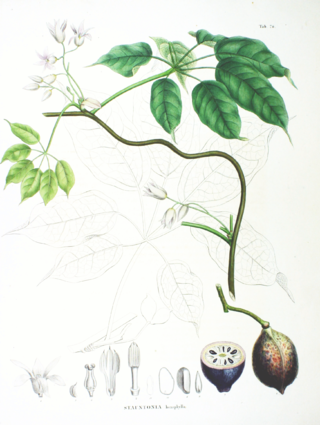
Stauntonia is a genus of flowering plants in the family Lardizabalaceae. It is named after George Staunton, who brought it to Britain from China in the 19th century.

Tetrastigma is a genus of plants in the grape family, Vitaceae. The plants are lianas that climb with tendrils and have palmately compound leaves. Plants are dioecious, with separate male and female plants; female flowers are characterized by their four-lobed stigmas. The species are found in subtropical and tropical regions of Asia, Malaysia, and Australia, where they grow in primary rainforest, gallery forest and monsoon forest and moister woodland. Species of this genus are notable as being the sole hosts of parasitic plants in the family Rafflesiaceae, one of which, Rafflesia arnoldii, produces the largest single flower in the world. Tetrastigma is the donor species for horizontal gene transfer to Sapria and Rafflesia due to multiple gene theft events.
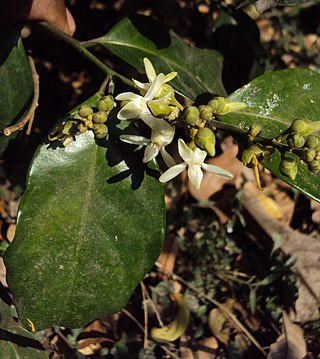
Xanthophyllum is a genus of about 109 species of trees and shrubs, of the plant family Polygalaceae;. The generic name is from the Greek meaning "yellow leaf", referring to how the leaves are often yellow when dry. In Borneo it is known as minyak berok in Malay or nyalin in the Iban language.

Solute carrier family 52, member 3, formerly known as chromosome 20 open reading frame 54 and riboflavin transporter 2, is a protein that in humans is encoded by the SLC52A3 gene.
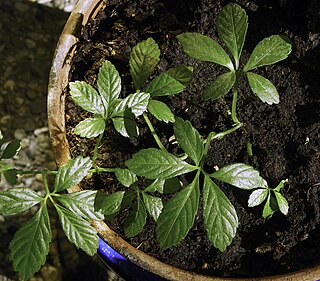
Gynostemma is a genus of perennial climbing vines in the cucumber, gourd, and melon family, comprising at least 19 species, all native to the tropical East or Far East, inclusive of the Himalayas: China ; the islands of Japan; Malaysia; and New Guinea. The term Gynostemma is derived from Ancient Greek γυνή meaning "woman" or "female", and στέμμα meaning "wreath" or "garland". In (post-)classical Latin the form stemma is attested as Greek loanword. In Ancient Greek and Latin, stemma is of neuter gender. German-Dutch botanist Carl Ludwig Blume described Gynostemma from two species he named: G. pedata and G. simplicifolia. Neither species was clearly designated by him as the type; however, the former species, G. pedatum is now considered to be a synonym of G. pentaphyllum(Thunb.) Makino. The genus was published in 1825, in Carl Ludwig von Blume's Bijdragen tot de flora van Nederlandsch Indië.

Cayaponia is among the largest genera in the gourd family, Cucurbitaceae, with 74 species. The plants are referred to as melonleaf. They are common from the southern United States to South America. Some species are also found in western Africa, Madagascar, and Fernando de Noronha, which is about 354 km (220 mi) off the coast of Brazil.
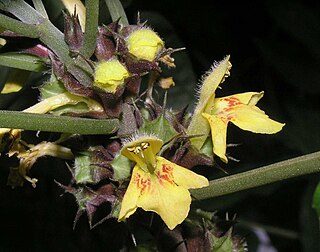
Paraphlomis is a genus of flowering plants in the mint family, Lamiaceae, first described in 1901. It is native to China, Himalayas, and Southeast Asia.

Kedrostis is a genus of ± 35 species climbing or trailing herbs in the family Cucurbitaceae. Its native range is tropical Africa and Asia.
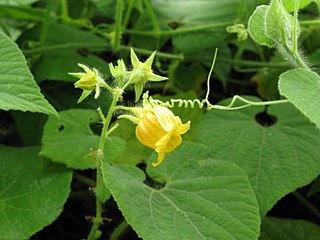
Thladiantha is a genus of flowering plants in the family Cucurbitaceae, native to the Indian subcontinent, Southeast Asia, and China. They are dioecious, perennial herbs. The best known species is Thladiantha dubia.

Echinopepon is a genus of flowering plants in the family Cucurbitaceae, native to the southwestern United States, Mexico, Central America, and South America. Tendrillate vines, their prickly fruits are operculate, with the prickles themselves being stipitate glandular.
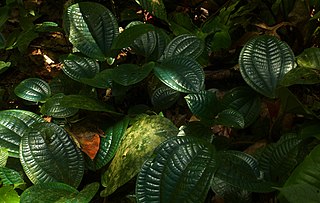
Phyllagathis is a genus of flowering plants in the family Melastomataceae, native to India, southern China, Southeast Asia, and Malesia. The taxon is believed to be highly polyphyletic.
Papuasicyos is a genus of flowering plants belonging to the family Cucurbitaceae.

Solena is a genus of flowering plants belonging to the family Cucurbitaceae.

Oreocharis is a genus of flowering plants in the family Gesneriaceae. It includes 154 species native to Asia, which range from the Eastern Himalayas and Tibet through Indochina and China to Japan.
















